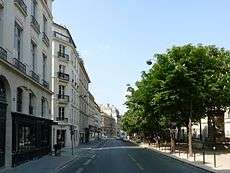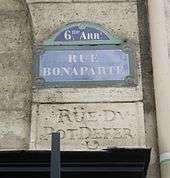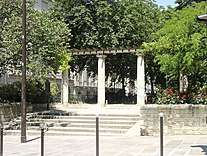Rue Bonaparte
Rue Bonaparte is a street in the 6th arrondissement of Paris. It spans the Quai Voltaire/Quai Malaquais to the Jardin du Luxembourg, crossing the Place Saint-Germain-des-Prés and the place Saint-Sulpice and has housed many of France's most famous names and institutions as well as other well-known figures from abroad. The street runs through the heart of the fashionable Left Bank and is characterised by a number of 'hôtels particuliers' (grand townhouses) and elegant apartment buildings as well as being bounded by the river at one end and the park at the other. With fifteen buildings or monuments classified as Monument Historique, it has more such listed sites than any other street in the 6th arrondissement.
 view starting at no. 88 rue Bonaparte from the rue de Vaugirard | |
 Shown within Paris | |
| Length | 1,010 m (3,310 ft) |
|---|---|
| Width | 11 m (36 ft) |
| Arrondissement | 6th |
| Quarter | Saint-Germain-des-Prés, Odéon |
| Coordinates | 48°51′11″N 2°19′59″E |
| From | 7 Quai Malaquais |
| To | 58 rue de Vaugirard |
| Construction | |
| Completion | Ord. du 7 septembre 1845 |
| Denomination | 12 August 1852 |
Rue Bonaparte also has many literary associations and contains a number of bookshops, antiquarian booksellers, publishers and art galleries. Its architecture and location have made it one of Paris' most historic and sought-after residential addresses.
| Located near the Métro stations: Saint-Sulpice, Mabillon and Saint-Germain-des-Prés. |
History
The length of the street was formerly the site of a river called La Noue, which at the time formed the eastern boundary of the Pré-aux-Clercs (an area of land belonging to the Abbey of Saint-Germain-des-Prés). Later, the river was enlarged into a 27-m wide canal and named Petite Seine ('Little Seine'), which in turn supplied water to the moat of the Abbey of Saint-Germain-des-Prés when its fortifications were built during the 14th century. In the 17th century, those fortifications were demolished along with the moat and the canal.

At one time, it was divided into two streets - the rue du Pot de Fer dite du Verger and the rue des Petits Augustins (also known variously in the late 16th century as the rue Bouyn, Petite rue de Seine, Rue de la Petite Seine and the Chemin de la Noue). Its present form was established by government decree on 7 September 1845, which resulted in the opening of the part of the street between the Boulevard Saint-Germain and the rue du Vieux-Colombier. Its name was subsequently changed on 12 August 1852 to commemorate the Emperor Napoleon I.
The name 'Rue Bonaparte' was first proposed during the period of The Consulate; it was formally renamed "Saint-Germain-des-Prés" under the Bourbon Restoration, and then officially regained the name of "Bonaparte" a few months after the coup of Louis Napoleon Bonaparte, in August 1852.[1]
Composition
In its present form it has subsumed the following historic streets:
- Rue des Petits-Augustins, between the quai Malaquais et the rue Jacob
- Rue Saint-Germain-des-Prés, opened in 1804, between the Rue Jacob and St-Germain-des-Prés, it was named variously the Cour des Religieux, Rue Bonaparte, rue de la Poste aux Chevaux and in 1816 rue Saint Germain des Prés, before finally reassuming its current name.
- Rue Saint-Germain, between the Place Saint-Germain-des-Prés and the Place Saint-Sulpice was named in 1847. In 1804, this part of the street, which at times was known as the old rue Saint-Germain-des-Prés, ran between the rue Jacob and the rue du Vieux Colombier.
- Rue du Pot de Fer Saint-Sulpice, between rue du Vieux-Colombier and the rue de Vaugirard, was named in the 15th century Ruelle Saint-Sulpice, then Ruelle Henri du Vergier, then Rue du Verger. At the beginning of the 17th century, it was renamed rue du Pot de Fer dite du Verger. Some historians suggest that it was also known as rue des Jardins Saint-Sulpice and rue des Jésuites.
- Rue du Luxembourg in 1879, was the name given to the part comprising the rue de Vaugirard and the Rue d'Assas, then in 1918, the name Rue Guynemer.
Landmarks
The rue Bonaparte itself contains some of Paris' notable landmarks, including:
- The Ecole de Beaux Arts
- The Académie nationale de médecine
- The Place Saint Germain-des-Prés
- The Abbey of Saint-Germain-des-Prés
- The Fontaine de la Paix
- The Church of Saint-Sulpice
- The Saint-Sulpice Fountain
- The Promenade de l'allée du Séminaire
- The Jardin du Luxembourg is at its southern tip
Notable addresses
- No. 5: Birthplace of the French painter Édouard Manet (the street was then called rue des Petits Augustins) on 23 January 1832. Home of French field marshal and colonial administrator le Maréchal Hubert Lyautey from 1911 to 1934. French National Heritage site (Monument historique).
- No. 13: Art studios of Modernist French painters André Derain and André Dunoyer de Segonzac, as well as Anglo-French painter Paul Maze.[2]
- No. 14: The École nationale supérieure des Beaux-Arts. French National Heritage site (Monument historique).
- No. 16: Académie nationale de médecine (The National Academy of Medicine). French National Heritage site (Monument historique).
- No. 18: Site of the first provisional government of Czechoslovakia in 1916. It is marked by a plaque which reads "Ici en 1916 le gouvernement provisoire tchecoslovaque établit son siège sous la présidence de T. G. Masaryk".
- No. 19: Home of the French painter Amédée Jullien from 1861 to 1875. French National Heritage site (Monument historique).
- No. 20: Home of the American woman of letters, Natalie Barney, from 1909 to 1969. In her literary salon she played hostess to many of the 20th century's most important writers and artists from both sides of the Atlantic including André Gide, Paul Claudel, Scott and Zelda Fitzgerald, Ezra Pound, James Joyce, T. S. Eliot, Samuel Beckett, and Françoise Sagan. (Incorrect. Barney lived nearby at 20, rue Jacob. It is just around the corner. See wiki entry on Barney.
- No. 24: The American novelist Henry Miller stayed at no. 24 between 1928 and 1930 during which time he began his relationship with the American writer Anaïs Nin.
- No. 30: The restaurant at no. 30, the Café Pré aux Clercs, was Ernest Hemingway's favourite haunt in Paris.[3]
- No. 31: The Salon des Cent was established there in 1894.
- No. 34: Workshop of the famous painter François Gerard. Home of Romy Schneider in the 70's and of Georges Wolinski from 1974 to 2008.
- No. 36: Home of French philosopher and sociologist Auguste Comte, between 1817 and 1822, during which time he published his first essays.
- No. 42: Home of French philosopher Jean-Paul Sartre and Simone de Beauvoir, from 1945 to 1962.[4] During this period Sartre was involved in establishing the quarterly literary and political review, Les Temps Modernes (Modern Times) as well as publishing some of his best-known works including: Les Mains Sales (Dirty Hands), Les Chemins de la Liberté (The Roads to Freedom), the Critique de la raison dialectique (Critique of Dialectical Reason), and Les Mots (The Words), La Mort dans l'Âme (Troubled Sleep - also known as: Iron in the soul), The Devil and the Good Lord / Le diable et le bon dieu, Kean, Les séquestrés d'Altona (The Condemned of Altona).
- No. 88: Dating from 1680, this 'hotêl particulier' was the home of French Cardinal, diplomat and man of letters Melchior de Polignac from 1732 until his death in 1742.[5] The mansion was then taken over and partly redesigned in 1790 by the French Revolutionary politician and lawyer Maximilien de Robespierre, who lived there until 1791, but then moved to a place of greater safety in the wake of the massacre on the Champ de Mars. From Robespierre's death in 1794 until 1815 it was the residence of French Catholic priest, abolitionist and revolutionary Abbé Gregoire.[6] French National Heritage site (Monument historique).
- No. 92: The Hungarian Cultural Institute
- Other notable current and former residents are Voltaire, Nancy Cunard, Catherine Deneuve, and Romy Schneider.
References
- Mémoires de la société de l'histoire de Paris et de l'Ile-de-France, p. 18.
- Turner, Sarah A. M.,. Percy Moore Turner : connoisseur, impresario & art dealer. London. ISBN 978-1-910787-80-9. OCLC 990973672.CS1 maint: extra punctuation (link) CS1 maint: multiple names: authors list (link)
- "Hemingway's Paris - Wiki Travel Guide". Travellerspoint. 15 May 2007. Retrieved 5 October 2013.
- Terresdecrivains.com. "Sur les pas des ecrivains : Jean-Paul SARTRE". Terresdecrivains.com. Retrieved 5 October 2013.
- "Paris : histoire rue Bonaparte. Rues autrefois". Paris-pittoresque.com. Retrieved 5 October 2013.
- "Rue Bonaparte - Paris Révolutionnaire". Parisrevolutionnaire.com. Retrieved 5 October 2013.
External links

